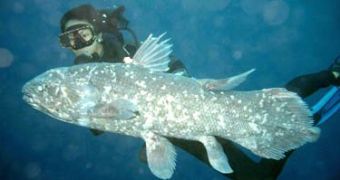This is our direct fish ancestor. Its extinct relatives had lungs and this fish is lobed finned resembling a leg structure. About 375 million years ago, its ancestors made the step to the ground evolving to the line that produced amphibians and after that reptiles, birds and mammals (including us).
It has almost 2 m (6.6 ft) in length, 110 kg (250 pounds) in weight and looks like a marine dinosaur. It inhabits the ocean depths, at over 200 m (660 ft) from the surface, in cold waters amongst the rocks, in groups spending the day inactive in grottoes. It is Latimeria, an animal that dwells the Earth for over 400 million years ago. All the researchers thought this type of fish had disappeared forever at the same time with the dinosaurs, 65 million years ago.
So that you can image the surprise of the researchers when in 1938 the first coelacanth fish, Latimeria chalumnae, was discovered at Soduana, several hundreds of km off South African coasts. It was like discovering a living dinosaur!
Its closest relative is a 70 million years old fish, Macropoma, found in fossil beds in Europe.
Since then another populations of Latimeria were found in other places of the Indian Ocean: off Comoros, Mozambique, Madagascar, Kenya, Tanzania, Sodwana Bay (South Africa).
But the biggest surprise was the discovery of a second species of Latimeria in Indonesia, in 1997. Initially the fish was found in a market; later living individuals were captured off Manado Islet (near Sulawesi Island). The new species was baptized Latimeria menadoensis and unlike L. chalumnae, which is bluish with white dots, the Indonesian species is brown with white dots. The largest individual of L. menadoensis was 1.3 m (4.3 ft) long, weighing 50 kilograms (110 pounds), with the same three parts tail like L. chalumnae. This species seems to dwell shallower waters, at even 100 m (330 ft). Mitochondrial DNA analysis confirmed that the two types of Latimeria represent different species.
But there are still many unknown issues about the behavior of the coelacanths: how it exactly moves at that depth, using its lobbed paired finds and three lobbed caudal fins, or how it reproduces. It is known that females are ovoviviparous (they do not spawn but keep the eggs, each one the size of a tennis ball, inside their bodies) and give birth between 5 and 25, after a gestation of 13 months, but they are believed to reach sexual maturity after 20 years of age. Coelacanths are ovoviviparous. The recordings show a juvenile for each two adults, which means a low reproductive rate. Living coelacanths do not have lungs and their back bone is largely cartilaginous.
It is estimated there are no more than 500 individuals worldwide, so this species needs strict protection; anyhow, it is not appreciated by locals which consider its meat too greasy but trawlers can disturb the habitat of the species.

 14 DAY TRIAL //
14 DAY TRIAL //